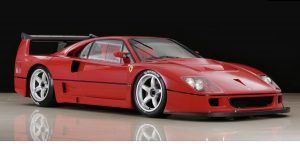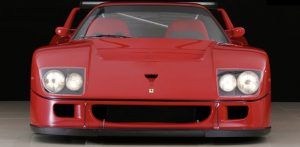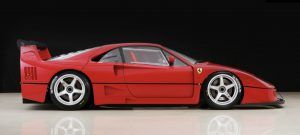All details and more photos HERE at bingosports.com
1994 Ferrari F40 Competition
Chassis no. ZFFGX34X000099401
・Fully restored by Michelotto Automobili
・As good as new
・Last of line that only produced 20
・Registered in Japan, allowed to drive on the streets
“Rare F40 competition perfectly restored by Michelotto Automobili”
Racing activity with F40 started under the leadership of Charles Pozzi SA, a Ferrari importer in France, who is well-known in racing industry. Back then, Racing division of the Ferrari Factory was focused on Formula One and Michellotto in Padova, Italy was assigned to development of the machine because they already had an experience on creating 288GTO Evolizione. Of course, Ferrari provided a big support for development of power train.
F40 Racing was called F40LM, short name for “Le Man”, and that was also decided based on the request by a French racing team. That was the name remind us of 250LM, 60’s racing car.
F40LM is a racing car that diverted from road car and only 2 cars were produced, and its usage as a race car was limited to IMSA (International Motor Sports Association).
It did not take long for V.I.P. customers to start requesting to have F40 with the same style of F40LM when they saw F40LM in IMSA. Ferrari was pleased to accommodate the requests by such customers and placed an order of the said vehicle to Michelotto Automibili and that was how F40 Competizione was created.
The distinguished exterior from base model attracts people’s attention. Fixed headlight, air duct on front cowl and movable rear spoiler are armed were installed to be competitive, yet remain gorgeous style. It was natural for F40 fans to tried to imitate the appearance of this vehicle.
As for an interior, F40 Competizione has more racing car-like taste than ever because digital meters and fire extinguisher are equipped and lining is done in very minimal amount.
Boost pressure was increased for the engine and it outputs more than 700hp that is 200hp more than the base model.
F40 Competizione was often called as F40LM because the design of exterior and interior, and the spec of power train are very similar to the ones that actually raced in IMSA.
This vehicle was sent to Michelotto Automobili of Padova to have very detailed restoration spending a full year from 2013 to 2014. Bodywork was done by Carrozzeria Nuova Rinascente (former Carrozzeria Cognolato) who had worked on the vehicle when it was first being produced. They did their work with scrupulous care throughout the vehicle even on the small details in order to recreate the quality of a brand new car. There is a restoration record with details of their work.
This is already registered in Japan, so it is ready for you to experience the legendary drive on the streets.
“The History of F40”
In 1986, the development of F40 was started and 288GTO Evoluzione, created in purpose of Group B competition, lay at the base of it. Insiders were calling the project as “Le Mans” and Michele Alboreto, a F1 driver, had joined the development team led by Nicola Materazzi.
A space structure with chrome molybdenum pipes holds the strong but light-weight cabin which constructed with many weightless parts i.e., Nomex, Carbon Kevlar, and Aluminum Honeycomb.
It was the traditional structure of Ferrari to have the cabin between suspension and power unit by combining with a sub-frame to accommodate them, but that tradition no longer seen after F40.
New weightless materials became possible to use because stress bearing to door panels were eliminated by the strong space structure. Carbon fiber is mainly used for the body panels and various composite materials are used on the chassis and the frame. A special glue was used to attach reinforcing materials onto the frames of pipe.
Under the supervision of Leonardo Fioravanti, a former chief designer of Pininfarina, Aldo Brovarone was in charge of exterior design. The most advanced aerodynamics was pursued with a large rear wing, a diffuser at the rear, and a flat floor. Blinkers and position lamps are covered by acryl and placed in the front of retractable headlights that are formed in thin rectangular shape.
NACA duct on the hood is for air conditioning and side intakes are for cooling intercooler and brakes. NACA duct is also on the upper fender as well and the left one is for oil-cooler for the engine; the right one is divided in two, the outer one is oil-cooler for the gear and the inner one is for the engine room.
Water-cooled V8 DOHC with 32 valves engine is named F120A. It is vertically mounted in the middle with twin IHI turbocharger and its displacement was increased from 2855cc of 288GTO to 2936; the turbo boost pressure was increased to 1.1 bar, maximum, from 0.8 bar. The fastest speed is announced to be 324km/h and maximum output of 478 PS and torque of 58.8km are recorded.
F40 was unveiled in Geneva Show in September of 1987 as a celebration of 40-year anniversary of Ferrari. The initial production volume was planned to be 400 cars, but 1351 cars were delivered because many of Ferraristas could not resist the beauty of F40 regardless of its price, 250,000 US dollars.
This vehicle has own extraordinary beauty of traditional body structure, different types of composite materials, and undeniable high performance. Many of F40 fans from all over the world are seeking for this machine, born in transition of 1970s’ super car generation to today’s super sports generation.
Photos by bingosports.com




